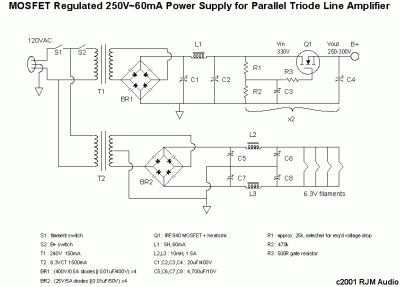Parallel Triode Line Stage.
Primitive ART and a nod of appreciation to Conrad Johnson.
If I needed a line stage, this is the circuitry I'd use. The parallel tubes lower the noise and output impedance. With four 6DJ8 triode sections per channel, the output impedance is 850 ohms. Gain is about 26 dB.
I didn't set out to reverse engineer the C-J preamp. I just read the Stereophile review, and set out to design my own preamp with the same tube configuration. I'd be willing to bet the amplifier circuit is very similar, as its so simple there are very few viable permutations. The power supply may be completely different, and the control circuitry most definitely is...
The Amplifier Circuit
Circuit walk through:
Just imagine a textbook triode gain stage and multiply by four. This halves the noise floor, and reduces the output impedance by 1/4. One channel requires 27 mA of current, and the power dissipation by the plate resistor R4 is over 5 W, so I recommend running many resistors in parallel to distribute the load. The cathode bias resistor is left unbypassed. Gain is halved, output impedance is raised slightly, but better bandwidth and linearity is obtained. Less gain is generally desirable in a line stage application. In most listening situations the overall gain is less than unity, so the less gain, the less the input signal must be attenuated and this improves signal-to-noise performance.
The Power Supply
This is the same power supply I used to successfully power the tube phono preamp, though here it is beefed up to handle the 60 mA circuit draw. One regulator section is used per channel, but of course dual mono 30 mA supplies would possible. The filaments are DC this time, as the cathode is unbypassed, the heater induced hum would be unacceptibly high. The scheme presented here is possibly overkill, but would guarentee a silent heater, something not always seen in conventional DC supplies.
This circuit and power supply is shown as a suggestion. I haven't built it, so it is not tweaked in any way. It's here because I haven't seen anyone post something like this on the net before, and because I think it should give you excellent performance at a very reasonable cost. Let me know if you try it.

|

